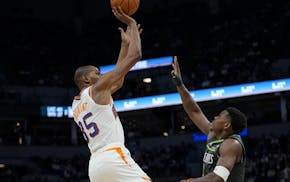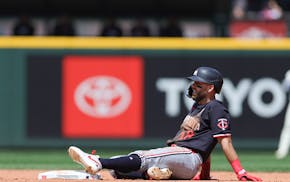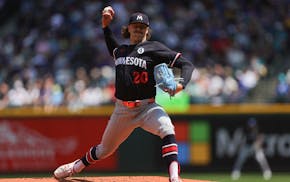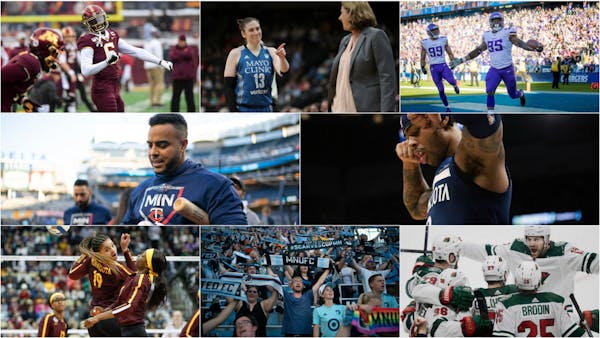The 60th training camp in Vikings history officially began more than a week ago. On Monday, as players are allowed to congregate on the field for the first time, it's hardly a stretch to say the 2020 camp already ranks as one of the strangest in team history.
The Vikings placed eight players, including Pro Bowl linebacker Anthony Barr and first-round pick Justin Jefferson, on the NFL's COVID-19 reserve list last week, after head athletic trainer and team infection control officer Eric Sugarman tested positive for the coronavirus himself. The total was near the top of the NFL after the first week of testing.
As the Vikings wait to get some of the group back, their healthy players will begin on-field preparation, with no fans in the training camp stands, for a season that will include no dress rehearsals.
This season will be the first in Vikings history without a preseason, thanks to an agreement between the league and NFL Players Association that eliminated exhibition games in the midst of the pandemic. If the league makes it to opening day, the first test for the Vikings' reworked defense will be Aaron Rodgers, in a building with only a smattering of fans.
As the NFL heads into the 2020 season with coronavirus tests and crossed fingers, here's a look at what to expect from a surreal Vikings training camp.
Testing and tracing a fact of life
All Vikings players who cleared the NFL's initial set of coronavirus screenings — with three negative tests in four days before being allowed to enter the team's practice facility — will be subject to daily COVID-19 tests for at least two weeks. If the positive test rate falls below 5% for all team personnel after two weeks, the Vikings can scale back to tests every other day. Test results are expected in 24 hours.
All team personnel are also wearing contact tracing monitors designed to help the Vikings isolate anyone who might have come in close contact with someone who tested positive.
Conditioning this week, practices next week
Even though NFL teams can get on the field Monday, they still won't begin practicing until Aug. 12. They'll spend the first segment of training camp in an eight-day conditioning period (with a mandatory day off next Saturday), to help replace a fraction of the training they lost with facilities closed and offseason programs canceled this spring.
By gradually bringing players back onto the field, the league and union hope to avoid a rash of soft-tissue injuries (such as hamstring and groin strains) that could come with an abrupt return to practices.
Players can spend 60 minutes in the weight room and do 60 minutes of on-field conditioning from Monday through Aug. 11. Teams can also have 60-minute walk-throughs during the first four days of the conditioning period, and 75-minute walk-throughs during the last four days.
Opt-out deadline still looming
Even though players can start working out this week, they've still got time to opt out of the 2020 season; the deadline for players to opt out is a week after the league and union sign their agreement about how the 2020 season will operate, though the league was reportedly seeking to move the deadline to the middle of this week. Players deemed to be high risk because of pre-existing medical conditions can collect a $350,000 payment for the 2020 season. Low-risk players receive a $150,000 advance on their base salary, with the remainder of their base salary pushed into 2021. The contracts of all players who opt out of the 2020 season (like Vikings nose tackle Michael Pierce) will roll over into 2021.
Practices: Lots to do in little time
A flurry of offseason moves means the Vikings will have at least four new starters on defense, including perhaps their youngest cornerback group in Mike Zimmer's seven seasons as head coach. With no preseason games, the Vikings will have to operate on a truncated timetable.
"We're going to have to set up situations throughout practice where we're, number one, we're going to have live contact," Zimmer said on July 25. "We're going to have to evaluate guys with some of our younger guys against our better guys and try to evaluate those players in those situations, so the evaluation part will probably be the biggest thing for a lot of these young guys."
Whatever the Vikings do, they'll have to work within tighter constraints than usual: Their first practice on Aug. 12 will be capped at 90 minutes; they can't put pads on until Aug. 17; and they can practice in pads only 14 times from Aug. 17-Sept. 6.
Defensive battles: Plenty of competition at corner
The Vikings' secondary will be a major focus of attention during camp, with starting cornerback spots up for grabs among Mike Hughes, Holton Hill, Kris Boyd and such rookies as first-round pick Jeff Gladney and third-rounder Cameron Dantzler.
Zimmer has typically preferred to bring young corners along slowly, and said on July 25 the Vikings would still "have to start with the baby steps: footwork and hand placement and technique."
If Gladney and Dantzler show they can pick up the particulars of Zimmer's defense quickly, though, they could have opportunities to contribute.
On the defensive line, the Vikings will have to figure out a plan at nose tackle; they seemed likely this week to stick with younger players such as Jaleel Johnson and Armon Watts, rather than pursuing a veteran, after Pierce opted out of the season.
Rookie James Lynch could make a quick impact as an interior pass rusher, and the Vikings will see if rookie D.J. Wonnum and free-agent pickup Anthony Zettel can replenish their depth behind Danielle Hunter and Ifeadi Odenigbo at defensive end.
Offensive battles: Interior line needs to be sorted out
The Vikings' lack of cap space this offseason meant they had few resources to improve their offensive line in free agency, and while second-round pick Ezra Cleveland could be the left tackle of the future, it's difficult to project whether he'll be ready to take on the starting job with only a few weeks of work in training camp.
That means if Riley Reiff stays at left tackle, the Vikings still need to figure out both of their guard spots, after cutting Josh Kline for cap reasons in March. Roster uncertainty could help Pat Elflein keep his spot, but second-year guard Dru Samia could push Elflein for a starting job. The Vikings will have to find another starter from the group of Dakota Dozier, Aviante Collins and Brett Jones, or potentially look at finding a veteran.
Their group of wide receivers will have a different look, too, with Jefferson on the COVID-19 reserve list and Stefon Diggs in Buffalo. Free-agent addition Tajae Sharpe and second-year man Bisi Johnson will get plenty of time to work alongside Adam Thielen, but the Vikings could use Jefferson's potential for dynamism if he's able to get healthy relatively soon. Chad Beebe has shown signs he can be effective, but he'll have to stay healthy in Year 3 to make the team.

Souhan: Will the Timberwolves trade for Kevin Durant? Should they?

Lynx improve to 7-0 with strong second half vs. expansion Valkyries

Twins lose in walk-off against Seattle for second straight game
Three-goal outburst in second half helps Minnesota United to rare victory in Seattle


